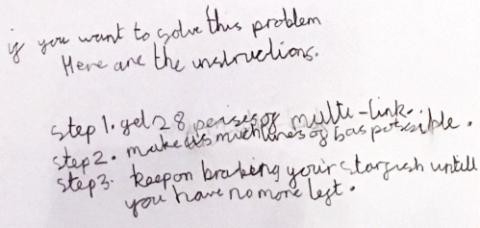Starfish spotting
How many starfish could there be on the beach, and how many children, if I can see 28 arms?
Problem

I can see 28 'arms' on the beach.
How many children could there be?
How many starfish could there be?
Getting Started
How will you remember what you have done so far?
You could use some sort of equipment to represent the arms, e.g. lolly sticks, straws or headless matches.
Student Solutions
Luis, Mason and Diego from Buckeye Elementary School in Arizona, USA sent in the following 3 solutions:
Children:4 Starfish:4; Children:9 Starfish:2; Children:14 Starfish:0;
Children:2 Starfish:1 I did this because some species of starfish have more arms than other species

Navdeep from Great Oaks Elementary School in Texas, sent in:
4 starfish = 20 arms; 4 kids = 8 arms; total 28 arms
Daisy and Amelie from Kingswear Primary wrote:
There could be 2 starfish on the beach and 9 children because children have 2 arms, double 9 would be 18. 18 plus the number of arms of 2 starfish which adds up to 10 because starfish have 5 arms, so you add 10 to 18 and you get 28.
Isabel from St Swithun's Prep School wrote about how to go about solving the task:

Isabella from York House School in Canada sent in the following:
We first figured out that the number of starfishes' legs have to equal an even number so that each human would have 2 arms. Then we did 5x4=20 and 28-20=8 and 8/2=4. I found other solutions by making a table.

Henry from Abbots Ripton sent in the following explanation:
I assumed that all starfish have 5 arms and all the children have 2 arms.
I figured out that you could have no starfish and 14 children.
You can't have 1 starfish as this leaves an odd number of arms, so you can have 2 starfish as this is 10 arms, and 9 children with 18 arms.
You can't have 3 starfish because that would leave an odd number of arms.
You can have 4 starfish and 4 children.
You can't have 5 starfish as the would give you an odd number of arms.
You can't have 6 starfish or more because it would be too much.
Lauren and Violet from Westridge School for Girls in Pasadena wrote a good explanation:
Our answer is 4 sea stars and 4 children. Our strategy is that we subtracted the number of arms by adding more stars and children. We started with number 28 and subtracted by 5s until we got 13. Then we started to subtract starting with 13 by 2s. When we got to 5, we realized that one sea star has 5 arms, so we subtracted the final 5 arms to get 1 more star and we had no arms left. Then we counted a total of 4 stars and 4 children.
Saya and Micaela from the same school said:
First we started with the number of arms, and we figured out that for the starfish we would have to have a multiple of five. So, then we knew that each of the humans would have a multiple of two. Then we took eight away from the 28 and divided the eight by two (for each of the humans). We got four.
Then we used the remaining 20 and divided that by five (for each of the starfish) and we got four. So our final answer comes out four humans and four starfish.
Thank you for these solutions, I just wonder how many different solutions there are for some different totals?
Teachers' Resources
Why do this problem?
Possible approach
Give children chance to consider the task completely on their own for a few minutes - display it on the screen so they also have the visual image of the starfish, and read out the challenge. Try to insist that there is no talking for these first few minutes so everyone really does have time to think about what they would do to start the problem. You might like to have mini whiteboards available so that learners can jot down their ideas.
Then invite learners to turn to a partner and share their thoughts. It might be that they have questions too, so after a little while, bring everyone together. Ask for pairs to suggest ways of beginning the task, or to share questions which they have not been able to answer. Look to other members of the class to provide comments, rather than doing this yourself.
Allow time for pairs to work together to find a solution. You may wish to post the following on the board as prompts:
- Can you find a solution?
- Can you find another solution?
- Can you find all the solutions? How do you know you've got them all?
In the plenary, you could draw out different ways of approaching the task that you have noticed e.g. by trying a random number of children and starfish, then adapting to get 28 arms; listing multiples of 2 and 5; working in a systematic way such as starting with all children; noticing that if the total number of arms is even then there must be an even number of starfish (or none at all) etc. (This is by no means an exhaustive list and children will find ways that surprise you!)
Key questions
How will you remember what you have found out so far?
